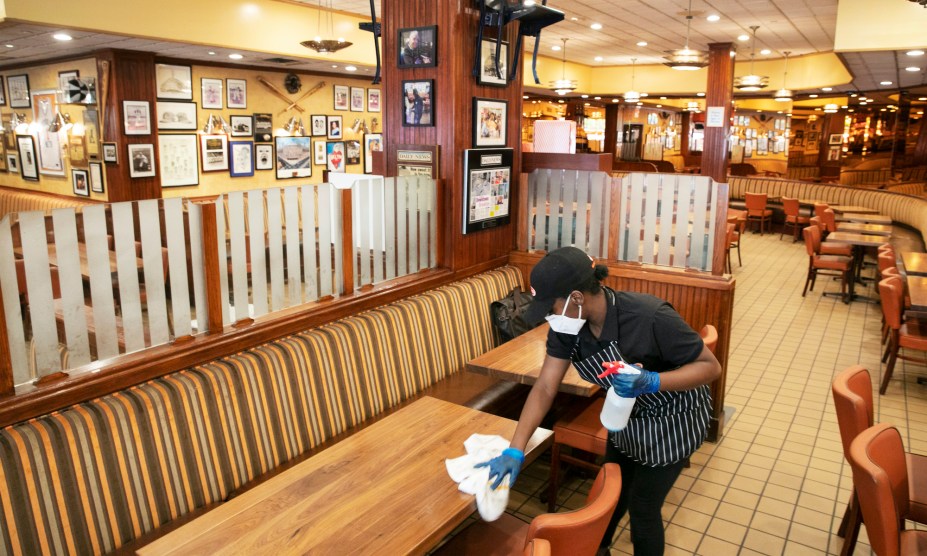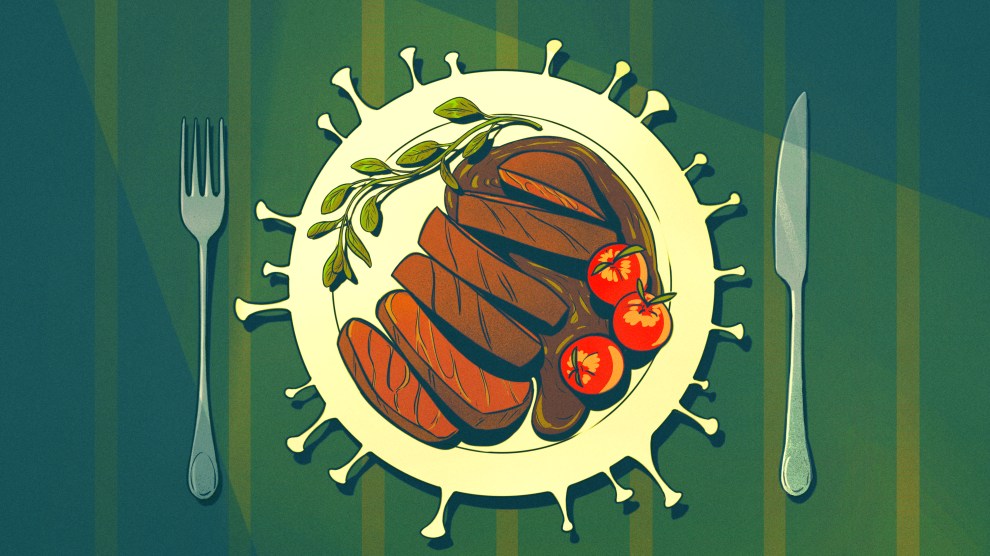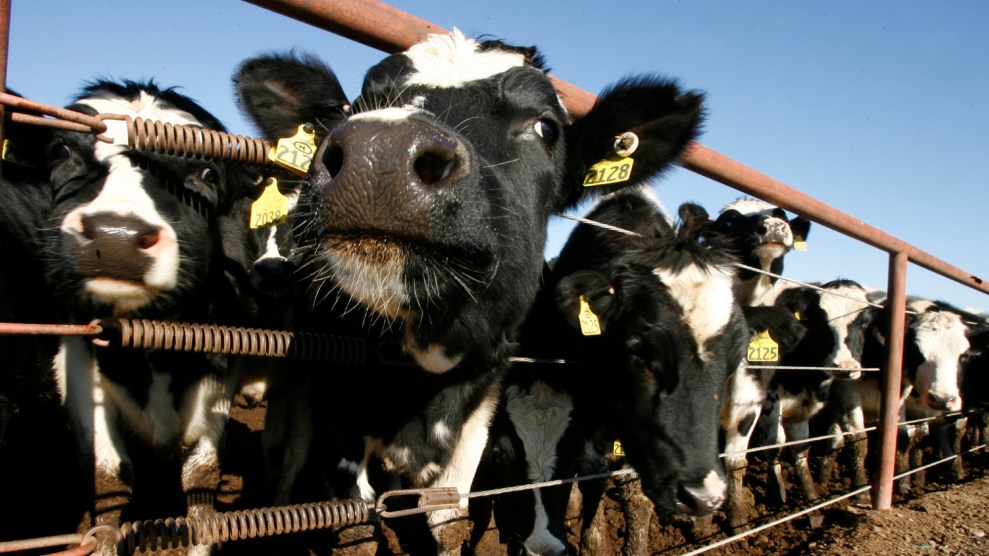
Junior's Restaurant in New York.Mark Lennihan/AP
This story was published originally by ProPublica, a nonprofit newsroom that investigates abuses of power. Sign up for ProPublica’s Big Story newsletter to receive stories like this one in your inbox as soon as they are published.
On Jan. 29, New York Gov. Andrew Cuomo was promoting “marital bliss” at a coronavirus news conference.
Announcing that indoor dining would reopen at 25 percent capacity in New York City on Valentine’s Day, and wedding receptions could also resume with up to 150 people a month after, Cuomo suggested: “You propose on Valentine’s Day and then you can have the wedding ceremony March 15, up to 150 people. People will actually come to your wedding because you can tell them, with the testing, it will be safe. … No pressure, but it’s just an idea.”
Cuomo isn’t alone in taking measures to loosen pandemic-related restrictions. Michigan Gov. Gretchen Whitmer allowed indoor dining to resume at 25 percent capacity starting Feb. 1. Idaho Gov. Brad Little increased limits on indoor gatherings from 10 to 50 people. Massachusetts Gov. Charlie Baker is raising business capacity from 25 percent to 40 percent, including at restaurants and gyms. California Gov. Gavin Newsom lifted stay-at-home orders on Jan. 25.
To justify their reopening decisions, governors point to falling case counts. “We make decisions based on facts,” Cuomo said. “New York City numbers are down.”
But epidemiologists and public health experts say a crucial factor is missing from these calculations: the threat of new viral variants. One coronavirus variant, which originated in the United Kingdom and is now spreading in the U.S., is believed to be 50 percent more transmissible. The more cases there are, the faster new variants can spread. Because the baseline of case counts in the U.S. is already so high—we’re still averaging about 130,000 new cases a day—and because the spread of the virus grows exponentially, cases could easily climb past the 300,000-per-day peak we reached in early January if we underestimate the variants, experts said.
Furthermore, study after study has identified indoor spaces—particularly restaurants, where consistent masking is not possible—as some of the highest-risk locations for transmission to occur. Even with distanced tables, case studies have shown that droplets can travel long distances within dining establishments, sometimes helped along by air conditioning.
We’re just in the opening stage of the new variants’ arrival in the United States. Experts say we could speed viruses’ spread by providing them with superspreading playgrounds or slow them down by starving them of opportunities to replicate.
“We’re standing at an inflection point,” said Sam Scarpino, assistant professor at Northeastern University and director of the school’s Emergent Epidemics Lab. Thanks to the arrival of vaccines, he said, “we finally have the chance right now to bring this back under control, but if we ease up now, we may end up wasting all the effort we put in.”
Dr. Luciana Borio, an infectious disease physician who was a member of the Biden-Harris transition team’s COVID-19 advisory board, put it more bluntly at a congressional hearing on Feb. 3. “Our worst days could be ahead of us,” she said.
I interviewed 10 scientists for this story and was surprised by the vehemence of some of their language. “Are you sure it could be that bad?” I asked, over and over.
They unanimously said they expected B.1.1.7, the variant first discovered in the U.K., to eventually become the dominant version of coronavirus in the U.S. The Centers for Disease Control and Prevention has estimated that B.1.1.7 will become dominant in March, using a model that presumes it’s 50 percent more transmissible than the original “wildtype” coronavirus. The model’s transmission rate was based on experience in the U.K., which first detected B.1.1.7 in September and saw an increase in cases that became apparent in December, straining hospitals despite stringent closures and stay-at-home orders. So while our country appears relatively B.1.1.7-free right now, the situation could look drastically different in a matter of months.
Experts are particularly concerned because we don’t have a handle on exactly how far B.1.1.7 has spread. Our current surveillance system sequences less than 1 percent of cases to see whether they are a variant.
Throwing an even more troubling wrench into the mix is that B.1.1.7 is continuing to morph. Just this week, scientists discovered that some B.1.1.7 coronaviruses in Britain had picked up a key change, known as the E484K mutation. That mutation had previously been found in the B.1.351 variant, which was first discovered in South Africa. Scientists have hypothesized that it’s the E484K mutation that has reduced the efficacy of some vaccines in South African trials, so this is incredibly worrying news.
“It’s really hard to thread this needle without sounding like a prophet of doom,” said Angela Rasmussen, a virologist at Georgetown University’s Center for Global Health Science and Security. While vaccines bring hope, she said, governors who are moving to expand indoor dining are “completely reckless”; if they don’t course correct, “I don’t think it’s hyperbolic to say the worst could be yet to come.”
The choices that our federal and state leaders make right at this moment will determine if we can bend the curve once and for all and start ending the pandemic, or if we ride the rollercoaster into yet another surge, this one fueled by a viral enemy harder to fight than ever before.
All of us have agency in deciding this narrative, Dr. Anthony Fauci, director of the National Institute of Allergy and Infectious Diseases, stressed. “Certainly you need to be prepared for the possibility that things might get worse in the light of the variants, but that is not inevitable because there are things that we can do to mitigate against it,” he said in an interview. “We’re not helpless observers of our own fate.”
Fauci urged states to “double down on your public health measures … to have virtually everybody wear masks, to have everyone maintain social distance, to have everybody avoid congregate settings, and to have everybody wash their hands very frequently.”
And don’t wait until it’s too late, warned Michael Osterholm, director of the Center for Infectious Disease Research and Policy at the University of Minnesota.
“We are so good at pumping the brakes after we’ve wrapped the car around the tree,” he said. The new variants aren’t being complacent. “There’s still a lot of human wood out there for this coronavirus to burn.”
To understand the epidemiologists’ warnings, it helps to understand what variants are, how they have been behaving and our limitations in knowing exactly how far they have spread.
People have a bad habit of anthropomorphizing the coronavirus: ascribing human-like intentions to it, as if a microbe can discern that we finally have a vaccine and try to evade it. But viruses don’t really have any schemes; they just reproduce. “Coronaviruses are a single strand of RNA in a sac of fat,” epidemiologist Larry Brilliant reminded me. “They’re preprogrammed to replicate and continue replicating. That’s their job.”
Once in a while, when a virus replicates, a mistake occurs, and a letter in the strand of RNA is copied inaccurately. That’s called a mutation. Many times, those mutations are neutral. Sometimes they are detrimental to the virus, and that lineage will quickly die off. Other times, they’re beneficial to the virus in some way, such as by making it more transmissible. When a version of the virus becomes functionally different, that’s when scientists consider it a variant.
As of Feb. 4, according to the CDC, the U.S. has found 611 cases of B.1.1.7, the variant first discovered in the United Kingdom, five cases of B.1.351, first identified in South Africa, and two cases of P.1., first identified in Brazil. But that’s almost certainly an undercount.
Part of the reason why epidemiologists are advocating for us to stay hunkered down is because the U.S. doesn’t know exactly where all the variant cases are.
The term that public health uses is “surveillance.” I like to think of it as having eyes on the virus. In order to have good eyes on where coronavirus infections are in general, all you need is the regular swab tests that we’re all familiar with. But in order to tell whether a positive case is the wildtype coronavirus or one of the more nasty variants, an additional step is needed: genomic sequencing. For that, the sample needs to be sent on to a lab that has specialized machinery capable of conducting sequencing.
Until recently, sequencing in the U.S. was a patchwork effort, conducted by a mix of academic and public health agency labs keen to track the evolution of the coronavirus. Though the CDC hosted a weekly call where those scientists already conducting sequencing could compare notes, there was no dedicated federal funding or coordination to ensure that samples were routinely gathered from across the country.
Today, the U.S. sequences less than 1 percent of its total cases. This is a pittance compared to the U.K., which sequences around 8-10 percent of its positive test results. But volume alone isn’t the only thing that matters. Representation, meaning where the samples come from, is another crucial factor. Since most of the sequencing so far has come from voluntary efforts, the U.S. has suffered from uneven visibility, with a whole bunch of eyeballs in parts of the country that are biotechnology and academic hubs, like Boston, San Francisco and San Diego, and less in “surveillance deserts” like North and South Dakota. There, barely any samples have been sequenced at all, even when those states had explosions of COVID-19 cases.
Dr. Phil Febbo is chief medical officer at Illumina, one of the world’s biggest sequencing technology companies. Like so many parts of the coronavirus response, keeping a lookout for variants has suffered from a lack of federal leadership, Febbo said. As early as March of last year, Illumina representatives began meeting with federal agencies, advocating for a national genomic surveillance system.
“We talked to any three-lettered agency we could,” Febbo said. “Those conversations were cordial: They said they heard what we were saying, but then they’d say, ‘But we need more tests, but can you do it in five minutes, can it be point-of-care?’” It wasn’t until Dec. 18, when B.1.1.7 was taking off in the United Kingdom, that Illumina finally got a call from the CDC offering to sign a contract with the company. (Since December, CDC has engaged Illumina to do surveillance work by signing two contracts potentially worth up to $4.6 million.)
Today, Illumina sequences positive samples that are passed on from a diagnostic testing company, Helix. Each RNA strand of the SARS-CoV-2 virus has about 30,000 nucleotides, each represented by one of four letters. Illumina’s sequencers read through each sample’s code and compare each letter to a reference sequence, looking for significant changes. The data gets passed back to the CDC, which uses location data stripped of personal identifiers to map the spread of any variants that Illumina has picked up.
The CDC said it has contracted with several large commercial companies with the goal of sequencing up to 6,000 samples a week by mid-February. Through another program, called the National SARS-CoV-2 Strain Surveillance System, state public health labs are supposed to send a total of 1,500 samples to the agency every other week. This program went into effect on Jan. 25 and is still ramping up, according to a CDC spokesperson.
Febbo says more can be done to increase surveillance. He notes that the Biden administration, while clearly more invested in variant surveillance than the Trump administration, hasn’t set a public target in the same way it has for vaccinations with its “100 million shots” campaign. Illumina estimates that sequencing 5 percent of all samples would allow us to be confident that we are catching all variants of concern, and he would like the Biden administration to make that a public goal. It can be done, Febbo says: “It hasn’t been the lack of capacity, it’s been the lack of will.”
Having clearer information about where variants are would give governors and local officials actual information with which to make decisions. Then they could say with confidence, “We can open indoor dining because we know that the variants aren’t circulating in our community.” Absent that information, the only thing we can do is act like the variants are here.
The good news is that so far, the vaccines that have been made available to the public appear to be reasonably effective against the coronavirus variants. They may be slightly less effective against B.1.351, the variant discovered in South Africa, but none of the variants are total “escapes,” so a vaccine should offer you at least partial protection against any form of the coronavirus you encounter.
All of the available shots give your immune system some familiarity with the virus, allowing it to be more prepared to meet the bug in the wild, whether it’s the original strain or a variant. Having a savvier immune system, in turn, means that even if you do get infected, you’re less likely to need to be hospitalized, and less likely to die.
“Regardless of what’s happening with this variant, we’re much better with [people’s immune systems] seeing SARS-CoV-2 after seeing the vaccine than not,” said Derek Cummings, a biology professor at the University of Florida’s Emerging Pathogens Institute.
However, we’re not very far along with vaccinations yet. As of Feb. 4, only 2.1 percent of the U.S. population had been reported to have received both doses of the vaccine; 8.5 percent had received one dose. That means we’re in a precarious moment right now where the vast majority of the U.S. hasn’t had a chance to get protected, and the variants have a window to multiply. (Of course, those who have already gotten sick with COVID-19 have natural immunity, but some scientists are concerned that those who develop only mild symptoms may not gain as much innate immunity as those who receive a vaccine.)
Of the scientists I talked to, Caitlin Rivers, a computational epidemiologist at Johns Hopkins Center for Health Security, was the most optimistic about a potential variant-fueled surge. “I do think that B.1.1.7 has the possibility to precipitate a wave, but it probably won’t be as bad as the last wave, because we have a lot of preexisting immunity and we are rolling out the vaccines,” she said. Thanks to the vaccines, the U.S. will have more population immunity by March, when the CDC predicts B.1.1.7 will become dominant, than the U.K. did when the variant hit there late last year. “It’s a low likelihood that we will have a gigantic fourth wave, but not impossible,” she said.
Still, Rivers said, “now is not the time to relax.” She, too, was critical of state policies to loosen restrictions. “When you create the same conditions that allowed the last surge, you should expect the same results,” she said. “Our main move should be to reduce transmission as much as possible while we vaccinate as much as possible.”
Time is not on our side, as the morphing B.1.1.7 variant showed us when it picked up the E484K mutation. While we are lucky that our vaccines still work against the current variants, we have to keep in mind that in this race between vaccines and variants, the variants aren’t staying static.
The big fear is that eventually, a variant will come along that provides the virus with a complete immune escape, preventing our vaccines from working against it. Even though we can update our vaccines, that would take time. The only way to guarantee that the virus won’t mutate into a variant that our current vaccines don’t cover is to lower transmission significantly, said genomic epidemiologist Alli Black: “The virus will continue to mutate as it continues to spread. We’re not going to stop that biological fact unless transmission stops.” And vaccinating everyone quickly is one key way to make it harder for the coronavirus to get from person to person in the first place.
“We need to start responding like the variants are going to take over and they are one of the biggest threats,” said Cummings, “or we won’t have vaccinated enough people when this rolls through.”
Throughout this pandemic, the U.S. has often been in the fortunate position of not being first when it comes to novel viral encounters. We weren’t the country where SARS-CoV-2 originated. We weren’t the place where B.1.1.7 was spawned. We’ve had the opportunity to look to other countries and learn from them, if only we’d choose to.
Epidemiologist after epidemiologist pointed out that the U.K., Denmark and Portugal required drastic measures—the dreaded L word, “lockdown” —to get B.1.1.7 under control. “We’ve seen that multiple different countries in Europe have had to close schools after making it a policy that schools would be the last to close,” Rivers, from Johns Hopkins, noted.
If we don’t want the same fate to befall the U.S., now is the time to act, the scientists urged.
Improving surveillance can help. Utah Public Health Laboratory has a robust state sequencing program, analyzing a random sample of cases sent by the state’s two largest hospital groups. Kelly Oakeson, its chief scientist for next generation sequencing and bioinformatics, has set a goal of sequencing 10 percent of all cases in the state; his lab is currently doing about 3 percent. They could do more, he said. The only problem is that they don’t have enough pipette tips due to a national shortage. Oakeson said he’s hoping that the Biden administration will leverage the Defense Production Act to produce more pipette tips so he can increase his state’s surveillance capabilities.
“We can’t get transmission down through vaccination alone,” said Rasmussen, the Georgetown virologist. “We need to be encouraging leadership, both at the state and federal levels, to protect people, to have paid sick leave for people if they become symptomatic.”
A restaurant server in New York City, who was laid off early in the pandemic from a high-end steakhouse, told me he understood what the epidemiologists were saying from a scientific point of view. But, he asked, “if you want to shut everything down, who’s going to pay the bills?”
He continued, “In order to do what the epidemiologists want to get done, you can only do that with policies to support the people and make it worth their while to do it.” He’s job hunting, and he said that if he was offered a position that put him indoors on Valentine’s Day, “I would have to take it.” He’d put on a double mask and go to work.
Whenever we have options, though, individual decisions can make a difference. Black, the genomic epidemiologist, encouraged everyone to limit travel as much as possible: “It just really facilitates introductions of these circulating variants.”
Hang in there, urged Scarpino, the Northeastern professor, painting a hopeful picture: “Cases are coming down, vaccines are going up. Let’s pretend that politicians wake up and don’t reopen restaurants and we avoid a big wave in March. Then we’re running downhill on the vaccines because the pipeline gets better and better. Then we can get our lives back.”
That sounded so tantalizing. Dream-worthy. Just a matter of good science-based public policy and collective compliance driving down the case counts until those little mindless RNA-filled fat sacs have nowhere to go, no one to infect, no way to replicate, no chances to mutate. I imagine them bumping around, lost without crowded indoor spaces to breed in, thwarted by vaccine-boosted immune cells, unable to find a host, dwindling, going, gone.
















